Introduction
Perhaps the most popular theory of Pierre Teilhard de Chardin was his Law of Complexification - Consciousness, where he stated that the progressive increase of complexity during evolution was paralleled by an increase in consciousness. This seemed to imply that even the simplest organisms, say viruses and atoms, have a kind of primitive, pre-biological consciousness. This led to speculations about a kind of soul, present in each existing organism. Hence notions as pantheism and even animism were but a little step.
Things become much clearer, intelligible and scientifically plausible, if one considers (human) consciousness as only the latest form in the development of an internal organizing system, taking several concrete forms during the evolution of the universe, from some primitive conditions at the subatomic level to full human consciousness. Using the word consciousness to point to those primitive forms is allowed, on condition that the definition of consciousness is extremely generalized, as to become a mere synonym for internal organizing system.
Definition
Internal Organization is that aspect of the organisms, developed during the evolution of the Universe, that controls the behaviour (i.e. the structure and/or the activities) of the organism. It develops alongside the complexity of the organisms: more complexiity enables a more elaborated organization, and on the other hand a more elaborate organization permits the structuration and functioning of an even more complex organism.
Remarks
1. Some may deplore this 'mechanical' defintion, and feel that it lacks an emotional, soul-like dimension. This is a classival problem in trhe development of hypotheses about the functioniong of the universe, and is discussed in a text about personalization aspects.
2. The vagueness of notions as structure and activities as dimensions of behaviour is inevitable, and is a typical aspect of systems (see texts on General Systems Theory). In highly evolved organisms as humans and society, aspects as activity, organization and information can clearly be distinguished form each other, and separate tools are provided for each of these functions. In more primitive organisms, those functions tend to fuse with each other, and specific tools tend to disappear.
When particles of an atom experience some 'information', e.g. receive one photon, their position (structure of the atom) and movement (behaviour of the atom) change. Information, structure and behaviour are rather aspects of the organism than parts of it.
Phases in the development of an Internal Organization System
One can discern three major stages in the development of an Internal Organization System. Teilhard labeled these stages as:
1. The lithosphere (also called geosphere or physiosphere). The possible positions, movements and interactions of the particles are primarily outlined by the structure of the particle and the more compex organism to which it belongs. This structure enables and elicits certain movements and positions, and prohibits some other.
The position and possible movements of an electron is delimited by the nucleus, and by the proximity of the surrounding electrons.
This phase or 'sphere' includes levels 1 to 5 of the evolution scheme: (1) superstrings, (2) quarks, (3) particles, (4) atoms, (5) molecules. In fact, it englobes the dead matter. Each particle interacts by the 4 fundamental forces of nature with the others in the neighbourhood, and its movements and changes are the resultant of these interactions. Coincidence and external events seem to be the major players in the evolutionary process at this level.
2. The biosphere. The structure of the organism and its possible activities are regulated by a central code. Two kinds of code exist: the cellular code (DNA, genes, chromosomes) and the behavioural code (the reflexes encoded in the brain). At the end of this phase (with the mammals) the behavioural code is extended with a learning ability, enabling the animal to add some personal reactions, based on its coincidental experiences, to the genetically transmitted reflexes.
This phase includes levels 6 to 8: (6) eobionts (also called organelles or protocytes), (7) protozoa, (8) metazoa.
At this point, nature adds some tricks to the evolutionary process, resulting in a significant acceleration of the evolution:
1. the progressive accumulation of experience. The DNA codes, eventually resulting in the genetic code on the chromosomes, is nearly never changed, but rather extended. If obsolete, some primitive functions are rather suppressed and inactivated than removed. Life develops as a phylogenesis rather than as an improvement by replacing the old codes. In hits personal development, each organism restarts this phylogenesis at an accelerated speed. We are able to retrace the evolution of species by comparing the common genetic codes.
Even the structure of the Central Nervous System consists of concentric layers, each added to the existing nervous system, whose primitive circuits (local nerves, spinal reflexes, cerebellar reflexes, etc.) remain in function, but are bypassed by higher functions, slower but more elaborated.
2. re-creating organisms rather than correcting them. Cells divide, metazoa procreate. At the metazoic level, nature even was unable to develop a suitable multiplication system, and simply preferred to start each multicellular organism again from an unicellular (spermatozoid and ovum). Such mulltiplication by re-creation implies also death of the individual organism, to recycle the scarcely available organic matter, and to get rid of worn out exemplars. This means that death, once the biophase is over, becomes unnatural and rather a waste than a evolutionary accelerator.
3. cross-over of experience. Very soon, long before the emergence of metazoa, nature introduced a cross-over of genetic material just before the mitosis. Of course, such a repeated combination of seperately accumulated enhancements, resulted into another spectacular acceleration of evolution. This cross-over, evolving eventually into marriage, is a beautiful analogon for intellectual interaction and sharing experiences at the noospheric level.
3. The noosphere. At this point nature leaves the time and energy consuming progression by structural changes, and switches to a kind of software progress: the behaviour of the, now intelligent, organisms rather progresses by intellectual, informational development. The same change occurred with our electronic devices, from computers to washing machines and mobiles: improvements are rather introduced by software updates than by hardware adaptations.
This transition was only possible because some developments occurred, including:
1. a frontal cerebral lobe. Man is the only mammal with a front. Even apes have flat sculls. This frontal lobe, probably the last addition of the biological evolution, enables man (1) to develop creative mental activities, by foreseeing some possibilities in his imagination, rather than having to try it out physically; (2) to develop abstract ideas, enbling him, by recombination, to imagine parts of reality he never observed or even could observe (e.g. the world of subatomic particles), to image parts of reality that not yet exist, --that's creativity.
This way man progressively develops an image of reality, i.e. a scientific knowledge, not only of the facts, but especially of the whole abstract infrastructure of existing and dormant reality.
2. language. This enables him (1) to transfer and concerve information (facts and, still more important, abstract ideas), speeding up the evolution of the indiovidual and the whole mankind; (2) to set up an internal speech, enabling him to label many of his abstract ideas, making them more accessible for intellectual processing.
Internet is the latest tremendous acceleration and qualitative explosion of this communication ability.
This switch from biophase to noophase implies the ending of the biological evolution, but not of evolution itself. The biological developmental evolution is supplanted by (a) a software (science and psychology), and (b) a technology.

Psychology --defined as the art of optimal human functioning-- is not just a science between countless other sciences, but takes over the torch of the evolution.
Schemes of consciousness and internal organization
a. Approaches
1. To illustrate the above hypotheses, some schemes could be uselful. Teilhard himself produced only a limited number of schemes, including this one on the development of the Noosphere (Noogenesis):
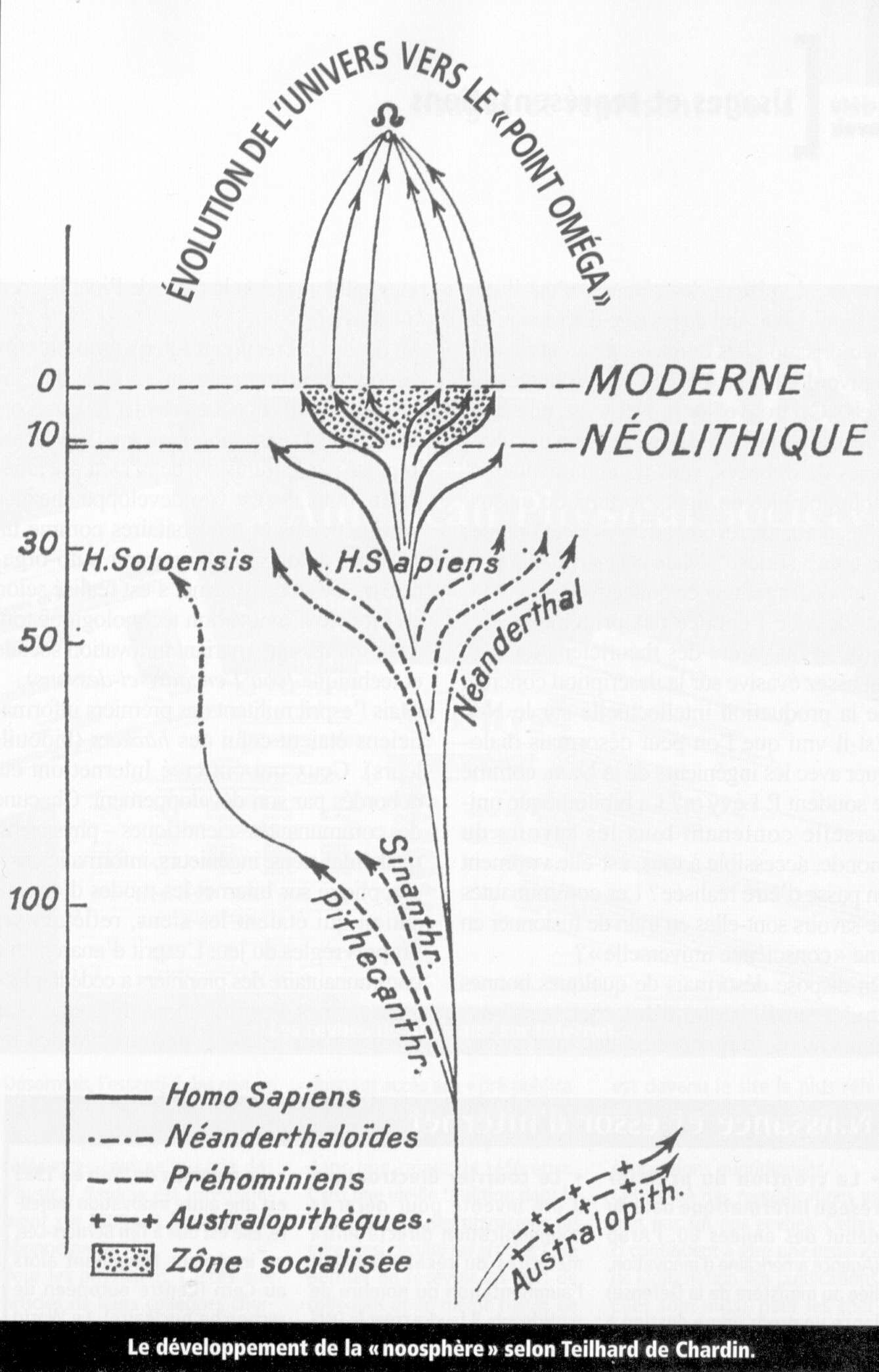
This scheme is important to illustrate the paradoxical phenomenon of a primary dispersion of the world of metazoa, mammals and hominoids, and a split up in races and social castes. But the extern factors of number and limited available place eventually elicited a move towards 'in-folding', an intellectual and factual integration, converging into the Omga Point.
2. Another scheme is this of Jacques Séverin Abbatucci, living in Caen, French Normandy, where he's leading a group of Teilhard enthusiasts. Inspired by the 4 major chapters of Teilhard's The Phenomenon of Man, he describes 4 phases, splitting up the Socialization or Noogenesis phase into the past part and the future part, ending up into 4 phases. The 5th phase, Omega, is just the endpoint of the 4th phase.

The development of the Internal Organization System is reduced to the Noosphere, presented here as an increase of consciousness.
3. The scheme of Max Wildiers clearly indicates the 9 known levels of the evolution and the three major organizational phases:
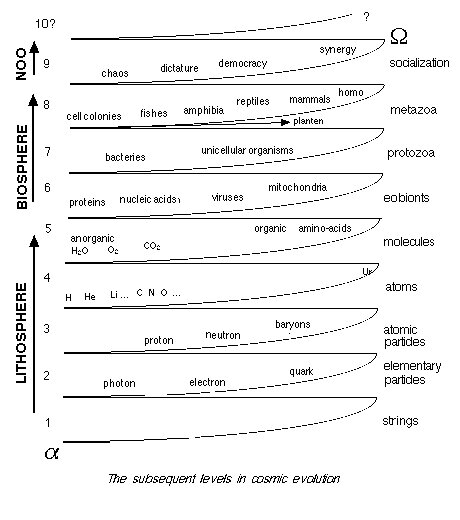
b. Towards a schematic representation of the Internal Organization System
1. At the lithosphere level:

The behaviour is determined by the structure.
2. At the biosphere level
a) with a genetic code:

The genetic code dramatically increases
the structural en interactional possibilities
b) with a set of reflexes:

An increasing set of instincts and reflexes,
genetically determined,
extends the behavioural possibilities
in relation with specific stimulating conditions.
c) with a sub-human brain:
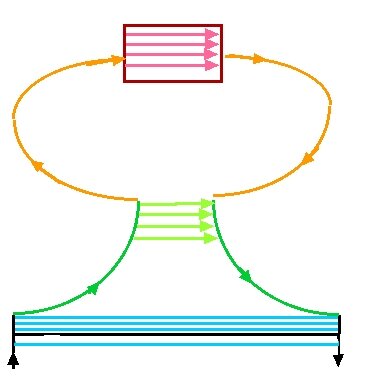
A brain (= connectivity and memory)
significantly extends the learning abilities of the animal
enabling it by coincidence and by trial and error
to add during its lifetime
myriads of new behavioural possibilities.
3. At the noospheric level:
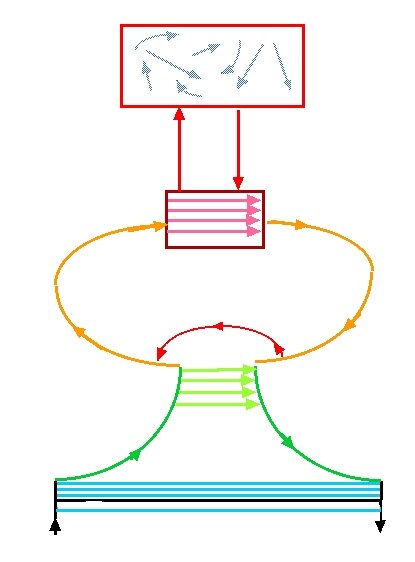
The brain circuit is closed in the frontal lobe
creating the ability for reflection without external input
conducting to the elaboration of a set of
suppositions and abstractions about reality
enabling consciousness and creativity.
The effects of consciousness
The developing conscousness and, in a lesser degree, the more primitive forms of Internal Organization during Lithosphere and Biosphere, provoke scertain effects: (1) intelligence, leading to (2) enhanced subjective fulfillment, and to (3) objective evolution of extern reality and universe.
1. intelligence
A growing collection of data about reality is stocked in memory. Due to the abstraction ability, and the closed reflection circuit in the frontal cerebral lobe permitting constant imagination, an increasing number of abstractions and hypotheses about reality are elaborated by inductive thinking.
This set of suppositions, true to a certain degree, enables the person, by deductive thinking, to make suppositions about parts of reality he never saw and perhaps never will or can see. But the same way thinking produces creativity, i.e. images about a reality that could but is not yet realized.
2. subjective fulfillment
An extending internal image of external reality, by knowledge and supposition, may enable the person to better get hold of his desires, dreams, abilities and the possibilities of the environment he lives in. Apart from a better statistical chance to realize his dreams, a feeling of increasing value, importance and happiness may be experienced. Furthermore, the experience of growing in itself is rewarding.
An intelligent view on reality not only helps to develop new successful interactions with this reality, but the expanding consciousness evokes an increasing feeling of importance.
3. objective completion of society, world and universe
Our conscious interaction with reality and the world we live in, may enable us to complete, at a greater speed than just left to blind coincidence, the evolutionary trend of the universe. As stated elsewhere, happiness, the sense of our existence, eventually consists in taking part in this grandiose project.
Starting at a very humble level, and making often the most dramatic errors, he apparently succeeds, by the integration of the initiatives of egotistic aspirations, to approach step by step this Omgea point. Of course, one can not be blind for the ever existing possibility that our world belongs to the statistical group of failures in this cosmic movement towards Omega. But it is still possible, in spite of so many mistakes, short-sighted and agressive projects, to keep a belief in a positive outcome (see texts on 'evil' and positive thinking).
Anyway, we can perhaps observe a progressive transition from egotistic chaos towards integrative synergy:
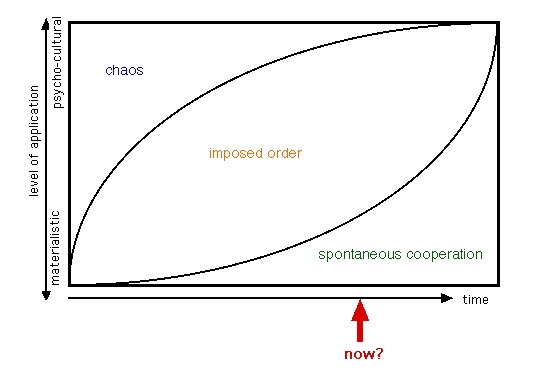
In this scheme, the x represents the progress of time, and y the level at which transitions occur: from simple, materialistic aspects of daily life, e.g. respecting the rules of traffic, towards high psychocultural concerns, e.g. searching together to find the secret of happiness in a long lasting love. This graph illustrates two tendencies:
(1) in the beginning human co-operation and social interaction is rather absent. There is a chaos where each person struggles for his own profits. The strongest dominate the less strong. Progressively, thanks to many forms of social and moral pressure, formerly imposed by kings, priests and other rulers, but nowadays achieved by revolutions, free press, trade unions and Non Governmental Organizations including Greenpeace and Amnesty International a kind of law and order is imposed. And finally, education and social sensitivity introduced enough moral responsability and long term thinking that spontaneous co-operation and mutual respect emerge.
(2) at the same time there is a progression from superficial, elemetary and 'material' topics to more cultural and psychological areas. The shift from chaos towards an imposed, and later a spontaneous order and coordination occurs first in the more direct and material domains, and only at a much later stage in the emotional, psychological, cultural and spiritual areas.
Legislation and education starts rather with regulations for traffic security and with the prevention of excessive forms of sexual misbehaviour than with more subtle questions including optimal communication, tenderness, positive thinking, spirituality etc.
It is important to consider that these 3 stages of socialization not only depend from the structures and personality of the dominating person or system, but also from the synergic maturity of the members of the organized group: a cooperating group of people is only able to function along a synergistic mode, on the condition they are well informed and have an intense and easy communication at their disposal, are able to make integrations with this information rather than choices, and can act with correctness and self-discipline. More primitive modes of social control in fact are a compensation for insufficient or less developed synergic maturity.
The second phase of socialization, called here imposed order, can further be subdivided into a number of sub-stages, e.g. (1) uncontroled domination (monarchy, dictature), (2) inspired domination (enlighted despotism, oligarchy), (3) controled domination (parliamentary monarchy, democracy). In a separate page we will extend this study of the socialization process.
These are the general trends. Of course, at a particular place and time in history this progress occurs probably less linearly, but with highs and lows.
Posted 3/02